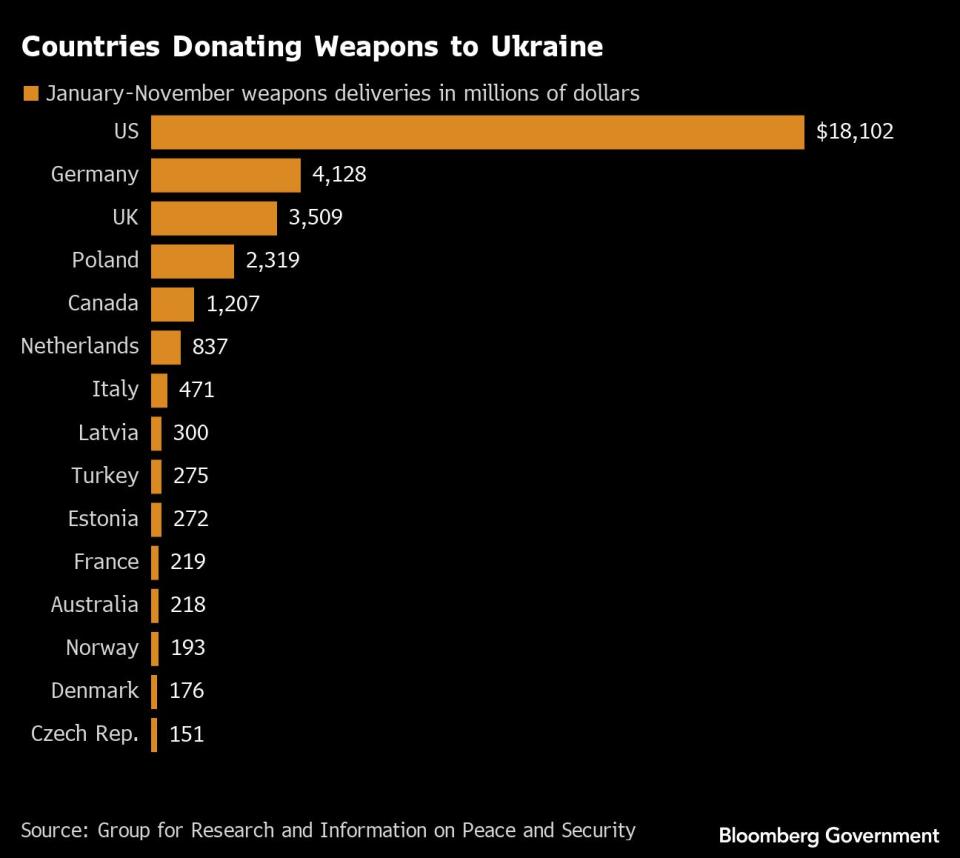Germany Pressures EU Allies to Send Ukraine Leopard 2 Tanks
(Bloomberg) -- Germany is increasingly concerned that European allies will not provide Ukraine with enough Leopard 2 battle tanks to create the promised two battalions of as many as 62 combat vehicles, with an escalation in fighting against Russia’s invading forces expected imminently.
Most Read from Bloomberg
Meta Asks Many Managers to Get Back to Making Things or Leave
George Santos Gets Into Fight With Mitt Romney at State of the Union Debut
Chinese Balloon Was Part of Years-Long Spying Program, US Says
DeSantis Chides Trump as Republicans’ 2024 Presidential Race Heats Up
Commodity Trader Trafigura Faces $577 Million Loss After Uncovering Nickel Fraud
Germany wants European allies with Leopard 2s in their military stocks to come up with concrete and detailed commitments by the end of this week, according to a person familiar with the government’s position.
That would enable officials from the Ukraine Defense Contact Group to take stock and push ahead with planning at a meeting of NATO defense ministers in Brussels on Tuesday, said the person, who asked not to be identified discussing confidential policy.
So far, talks with allies on pulling together the tank shipments appear to have yielded little. Besides Germany, only Portugal has made a concrete offer to send the most advanced tanks, but has left open how many, according to a German government official, who spoke on condition of anonymity because the discussion are confidential.
While EU member states such as Denmark, Norway, Finland and the Netherlands have suggested that they might send the tanks, they so far haven’t made clear commitments. Poland has said it will contribute 14 units of an older version of the Leopard 2, but will need spare parts from Germany. Those parts, however, are no longer in production.
Speaking after talks Wednesday with his Polish counterpart in Warsaw, German Defense Minister Boris Pistorius said the tanks coalition had still not achieved its targets and he hoped more countries with Leopard 2s would join the initiative.
“I think we could deliver at least one battalion in the first four months of this year, three months maybe, and then we have to proceed as fast as possible of course,” Pistorius told reporters.
In addition to the modern Leopard 2s, the German economy ministry this week approved the delivery of as many as 178 older-generation Leopard 1 battle tanks. The tanks, which were first built in the 1960s but are no longer in production, will come from stocks in Germany, Denmark and the Netherlands.
At least 100 of the tanks are due to arrive in Ukraine in the next few months. A German official pointed out, however, that the Leopard 1 will only serve as a supplement and possible source of spare parts for the Leopard 2s, which are much faster and better armed, and could therefore be a game-changer in the war in Ukraine.
Chancellor Olaf Scholz came in for criticism in recent months from EU partners for his apparent hesitation to supply Ukraine with battle tanks. On Jan. 25, he announced that Germany would send 14 state-of-the-art Leopard 2 A6s as part of a coordinated effort to provide two full battalions.
Scholz justified the relatively lengthy decision-making process by saying he had to coordinate with other allies. U.S. President Joe Biden agreed to send 31 Abrams tanks, but as they have to be built from scratch, that process will take more time.
The longer the EU conversation over tanks continues, the more likely it is to strain unity among member states, and the worse it is for Ukraine, which is expected to face a renewed Russian offensive in coming weeks.
In the German army, a battalion consists of 44 battle tanks, while in Ukraine it’s 31. A defense ministry spokesman said Wednesday that Germany and its allies are aiming to get together two battalions of Leopard 2 tanks under the Ukrainian definition and this would mean 62 units.
--With assistance from Piotr Skolimowski.
(Updates with German defense minister comments starting in sixth paragraph)
Most Read from Bloomberg Businessweek
©2023 Bloomberg L.P.



